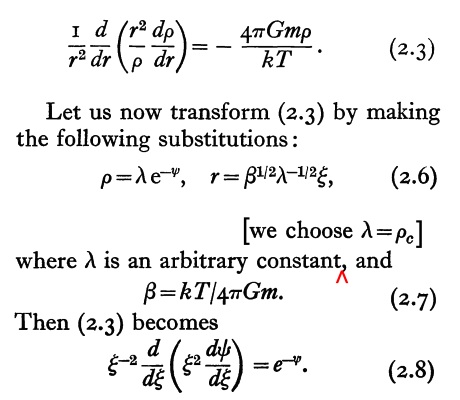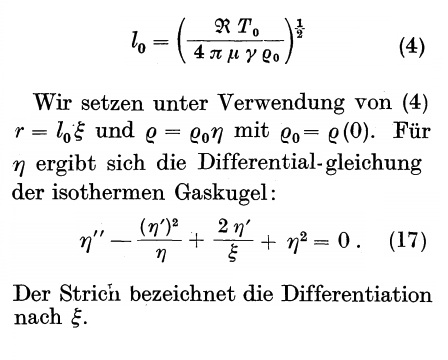Difference between revisions of "User:Tohline/SSC/Structure/BiPolytropes"
(→BiPolytropes: Add imagemap to link footnotes to relevant references) |
(→BiPolytropes: Work on early paragraphs and improve table layout) |
||
| Line 4: | Line 4: | ||
This discussion of bipolytropes is built upon the early ideas and mathematical foundation laid out by [http://adsabs.harvard.edu/abs/1930MNRAS..91....4M Milne (1930)], [http://adsabs.harvard.edu/abs/1931MNRAS..91..472C Cowling (1931)], [http://adsabs.harvard.edu/abs/1942ApJ....96..161S Schönberg & Chandrasekhar (1942)] and, especially, §28 (pp. 171-174) of [[User:Tohline/Appendix/References#C67|[<b><font color="red">C67</font></b>]]]. | This discussion of bipolytropes is built upon the early ideas and mathematical foundation laid out by [http://adsabs.harvard.edu/abs/1930MNRAS..91....4M Milne (1930)], [http://adsabs.harvard.edu/abs/1931MNRAS..91..472C Cowling (1931)], [http://adsabs.harvard.edu/abs/1942ApJ....96..161S Schönberg & Chandrasekhar (1942)] and, especially, §28 (pp. 171-174) of [[User:Tohline/Appendix/References#C67|[<b><font color="red">C67</font></b>]]]. | ||
While [[User:Tohline/SSC/Structure/Polytropes#Polytropic_Spheres|polytropic spheres]] can give us useful ''general'' insight into the internal structure of stars, they do not faithfully represent the detailed structure of most stars because the equation of state that is most relevant to the densest regions of a star usually is different from the equation of state that is relevant to the star's envelope. [http://adsabs.harvard.edu/abs/1930MNRAS..91....4M Milne (1930)] was among the first — if not the first — to suggest that more realistic models can be obtained by constructing a ''composite'' star. | |||
<div align="center"> | <div align="center"> | ||
| Line 9: | Line 11: | ||
<tr> | <tr> | ||
<td align="center"> | <td align="center"> | ||
[[Image:CowlingRE_Milne1931.jpg| | Excerpt from the introductory paragraphs of [http://adsabs.harvard.edu/abs/1931MNRAS..91..472C Cowling (1931)] | ||
</td> | |||
</tr> | |||
<tr> | |||
<td align="center"> | |||
[[Image:CowlingRE_Milne1931.jpg|500px|center]] | |||
</td> | |||
</tr> | |||
</table> | |||
</div> | |||
<div align="center"> | |||
<table border="1" cellpadding="5"> | |||
<tr> | |||
<td align="center"> | |||
Excerpt from §2 of [http://adsabs.harvard.edu/abs/1942ApJ....96..161S Schönberg & Chandrasekhar (1942)] | |||
</td> | </td> | ||
</tr> | </tr> | ||
Revision as of 18:47, 24 March 2013
BiPolytropes

|
|---|
| | Tiled Menu | Tables of Content | Banner Video | Tohline Home Page | |
This discussion of bipolytropes is built upon the early ideas and mathematical foundation laid out by Milne (1930), Cowling (1931), Schönberg & Chandrasekhar (1942) and, especially, §28 (pp. 171-174) of [C67].
While polytropic spheres can give us useful general insight into the internal structure of stars, they do not faithfully represent the detailed structure of most stars because the equation of state that is most relevant to the densest regions of a star usually is different from the equation of state that is relevant to the star's envelope. Milne (1930) was among the first — if not the first — to suggest that more realistic models can be obtained by constructing a composite star.
|
Excerpt from the introductory paragraphs of Cowling (1931) |
|
Excerpt from §2 of Schönberg & Chandrasekhar (1942) |
|
<imagemap> Image:SchonbergChandra1942.jpg|600px|References rect 0 480 210 580 User:Tohline/PGE rect 260 480 850 580 User:Tohline/Appendix/References#C67 desc none </imagemap> |
As has been derived and discussed elsewhere, an isolated isothermal sphere has a density profile that extends to infinity and, correspondingly, an unbounded total mass. In an astrophysical context, neither of these properties is desirable. A more realistic isothermal configuration can be constructed by embedding the structure in a low density, but hot external medium whose pressure, <math>P_e</math>, confines the isothermal configuration to a finite size. In a mathematical model, this can be accomplished by ripping off an outer layer of the isolated isothermal configuration down to the radius — label it <math>\xi_e</math> — at which the configuration's original (internal) pressure equals <math>P_e</math>; the interior of the configuration that remains — containing mass <math>M_{\xi_e}</math> — should be unaltered and in equilibrium. (This will work only for spherically symmetric configurations, as the gravitational acceleration at any location only depends on the mass contained inside that radius.) Ebert (1955) and Bonnor (1956) are credited with constructing the first such models and, most significantly, discovering that, for any specified sound speed and applied external pressure, there is a mass above which no equilibrium configuration exists. We present, here, the salient elements of these (essentially equivalent) derivations.
Prior to studying this discussion of pressure-bounded isothermal spheres, we recommend studying our related discussion of pressure-bounded <math>~n</math> = 5 polytropes. As with isolated isothermal spheres, isolated <math>~n</math> = 5 polytropes extend to infinity. But, unlike their isothermal counterparts, the structure of <math>~n</math> = 5 polytropes is describable analytically. Hence, an analysis of their structure and its extension to pressure-bounded configurations avoids the clutter introduced by a model — such as the isothermal sphere — that can only be described numerically. As it turns out, the pressure-bounded <math>~n</math> = 5 polytrope exhibits a Bonnor-Ebert type limiting mass that is analytically prescribable. Its derivation is mathematically quite clean and provides a firm foundation for understanding the better known — but only numerically prescribable — Bonnor-Ebert limiting mass.
Governing Relation
The equilibrium structure of an isolated isothermal sphere, as derived by Emden (1907), has been discussed elsewhere. From this separate discussion we appreciate that the governing ODE is,
<math>\frac{1}{r^2} \frac{d}{dr}\biggl( r^2 \frac{d\ln\rho}{dr} \biggr) =- \frac{4\pi G}{c_s^2} \rho \, ,</math>
where,
<math>c_s^2 = \frac{\Re T}{\bar{\mu}} = \frac{k T}{m_u \bar{\mu}} \, ,</math>
is the square of the isothermal sound speed. In their studies of pressure-bounded isothermal spheres, Ebert (1955, ZA, 37, 217) and Bonnor (1956, MNRAS, 116, 351) both started with this governing ODE, but developed its solution in different ways. Here we present both developments while highlighting transformations between the two.
| Derivation by Bonnor (edited) | translation | Derivation by Ebert (edited) |
| <math>G \Leftrightarrow \gamma</math> | ||
| <math>\rho_c \Leftrightarrow \rho_0</math> | ||
| <math>\frac{kT}{m} \Leftarrow c_s^2 \Rightarrow \frac{\Re T_0}{\mu}</math> | ||
| <math>\beta^{1/2}\lambda^{-1/2} \Leftrightarrow l_0</math> | ||
| <math>e^{-\psi} \Leftrightarrow \eta</math> |
Both of these dimensionless governing ODEs — Bonnor's Eq. (2.8) and Ebert's Eq. (17) — are identical to the dimensionless expression derived by Emden (see the presentation elsewhere), namely,
<math> \frac{d^2v_1}{d\mathfrak{r}_1^2} +\frac{2}{\mathfrak{r}_1} \frac{dv_1}{dr} + e^{v_1} = 0 \, . </math>
The translation from Emden-to-Bonnor-to-Ebert is straightforward:
<math> \mathfrak{r}_1 = \xi|_\mathrm{Bonner} = \xi|_\mathrm{Ebert}~~~~\mathrm{and}~~~~e^{v_1} = e^{-\psi} = \eta \, . </math>
Related Wikipedia Discussions

|
|---|
|
© 2014 - 2021 by Joel E. Tohline |


